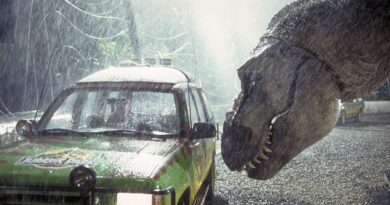Eggshells (1972)
Eggshells is an art film at odds with itself. Half of it is a snapshot of hippie life in Austin, Texas shot in a rough quasi-documentary style. The other half is a surreal dreamscape inspired by acid trips, and they may or may not have to do with something supernatural. What’s missing is the connection between the two. I understand that connections of any kind may not have been the intention, that the film always may have been meant to be a rambling series of scenes with no real pattern. Perhaps my brain is too logical, too accustomed to the confines of mainstream filmmaking, for me to fully accept the terms being set by first-time feature-length director Tobe Hooper. Or perhaps I should have watched the movie under the influence of something. I don’t know.
What is clear to me is that Hooper is an auteur with a genuine artistic vision and a willingness to experiment. Some of the visuals are as raw as home-movie footage, giving the film a cinéma vérité feel. Others rely on camera tricks, like cutting out every second or third frame to give specific scenes the rough look of heavily sped up stop-motion animation. Others still rely on psychedelic color schemes and lens filters that intentionally distort the images. The latter is especially important for one of the most unique sex scenes ever captured on film; the acid color scheme, coupled with extreme closeups and a bizarre warping effect, barely allow us to register the two naked bodies entwined with one another.
The more compelling scenes focus on two couples living in a hippie commune, which is really just a house on the outskirts of town that in all likelihood none of them pay to live in (“The house belongs to the earth,” one of them muses). I don’t think the point was to develop them individually as complete characters. Not fully, at least; we do know that two of them, Amy and David (Amy Lester and David Knoll), are on the verge of getting married, and since they’re presumably not employed, they’re excited to receive $500 from Amy’s father once the nuptials take place. We also know that the man in the other couple, bizarrely nicknamed Toes (Boris Schnurr), is a writer. We know absolutely nothing about his girlfriend Pam (Pamela Craig), other than the fact that she’s his girlfriend.
For the most part, we simply see them existing day to day. Each couple bathes in one tub, probably more out of there being only one bathroom and a limited supply of water. Together, apart, and in the presence of friends who often visit, they talk about everything and nothing in dialogue so naturalistic, I wouldn’t be surprised if it was all improvised. They sometimes take day trips in a car equipped with a plexiglass dome; it can be detached, and in one scene in a park, Amy and David lie underneath the dome in an intimate cuddle. We see some lovemaking, some pot smoking, and even a quietly amusing scene in which Pam is altering Amy’s surprisingly traditional wedding dress as she’s wearing it. We also see them in dialogue-free scenes that capture the counterculture movement; we see masses of mostly college-age kids peacefully protesting the Vietnam war, going so far as to shake hands with members of the riot police, who aren’t needed but are there just in case.
All that would have been enough for me: Capturing on film a place, an era, a mindset that amounted to the late 1960s/early ‘70s. But intertwined in a subplot I just couldn’t make sense of – no, not even in the context of psychedelia. Another young man lives in the commune, although they don’t seem to notice him, and, although he doesn’t speak, he seems to regard them with anxiety. He discovers and seems entranced by … something in the basement. It’s not exactly frightening, but it’s definitely mysterious; it’s essentially a glowing light surrounded by fog, and seems to be connected to a tube in both the wall and ceiling. Is it a ghost? Something extraterrestrial? Is it affecting how the couples behave? Why else would Toes drive the domed car into a field before smashing the windshield with an axe, setting the car on fire, stripping naked, and watching calmly as the car explodes?
What are its intentions? Does it have any? I ask because it seems this being operates some kind of machine, in which you stick your head under what appear to be salon-style hair dryers. We see the machine in action during the final scene, and the results are … well, to be honest, I have no idea what the results are, not beyond the obvious of what we’re shown. How does it relate to the depiction of the two couples? It’s that lack of connection, that undefined narrative purpose, that prevents Eggshells from being the great work of art it could have been. There’s no doubt that Tobe Hooper is an honest to goodness filmmaker, uninhibited by convention, visually creative, able to make the most of what little he has to work with. Here’s hoping the best is yet to come.




